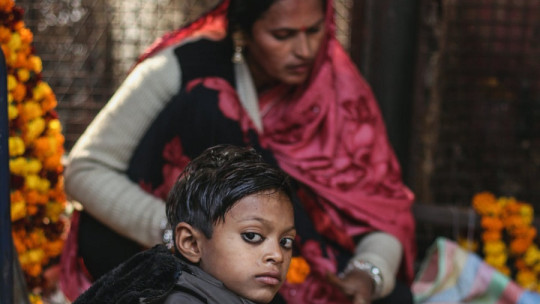
Dehumanization is the act and also the effect of removing a person or group of people from their characteristics that define them as human beings.
The 5 steps of dehumanization represent a process that together makes up a tool that has been of great help to certain groups in power throughout human history to contain numerous atrocities against other human beings.
Before explaining the 5 steps of dehumanization, it is advisable to reflect a little about what the word dehumanization really is.
What is dehumanization?
We should first ask ourselves the following: what does it mean to be a human person? To answer that we could say that a human person is one who has a series of rights by the simple fact of being one and they, in theory, should belong to all human beings equally.
Now, this idea that all human beings should have the same rights put into practice is very different. As we will see in this article, throughout history many people have been deprived of their rights, no longer being treated as human beings.
Dehumanization is a concept that It involves stripping a person or a group of people of their human characteristics and also of their rights as such In this context, it is a concept that has been widely used to explain human evil.
Throughout the history of human beings, a large part of the abuses perpetrated against certain groups of people who had been treated as if they were not human beings, draws attention to the fact that they had ordinary people as executioners; although it is true that said abuses occurred in unusual circumstances.
Let’s clarify this. It is true that at the head of those atrocities that were normally produced was a person or group of people that we could call cruel, ruthless and many other pejorative adjectives, but it is also true that these people alone would not have been able to commit those atrocities without the collaboration from other people who were under his command, whether under a feeling of fidelity, under duress, being in a desperate situation or out of fear.
Now, although many names come to mind because they have committed atrocious and despicable acts, the intention here is not to judge anyone in particular for their actions, but rather the crux of the matter is to reflect on the fact that In certain circumstances, a person without intentions of harming anyone could do so indirectly in a certain context or also under duress and this has been possible through a very powerful tool through a process divided by the 5 steps of dehumanization, as we will see below.
What are the 5 steps of dehumanization?
There are experts who affirm that crimes against humanity have been produced, in part, as a process of dehumanization, which is divided into different phases
The 5 steps of dehumanization occur successively, forming a powerful tool that allows a group of power, with a specific ideology, to coerce and condition other people, normally subordinated, to perpetrate a series of atrocities and even, although first hand they would never believe that they would be able to do something like that, get them to find a justification for doing it.
In contraction we will briefly see what the 5 steps of dehumanization consist of that can be part of the process behind crimes against humanity.
1. The creation of fear
The first step in this dehumanization to get a group of people to exceed ethical limits would be instill fear in them, fear for their own lives and those of their loved ones
Instilling fear in people about what could happen to them and their family is a tool that has been widely used by dictatorial regimes throughout history in various countries. By instilling fear in subordinates, they easily become scapegoats and in this way become responsible for the crimes committed.
In this first step, an ideology would begin to be forged in society, which can be based on preconceived ideas of racism, homophobia, etc.
2. Soft exclusion
The second of the 5 steps of dehumanization is soft exclusion, which consists of ensure that the group of subjects, who have become scapegoats, are excluded from some sectors of society (For example, the Nazis began excluding Jews from professions in public offices, such as hospitals and universities).
In this second step, the ideology of the power group would gain a certain solvency in society.
3. Documented justification for fear and exclusion
To carry out this third of the 5 steps of dehumanization, the power group uses media coverage and documented research in order to provide evidence and thus justify the reason for the exclusion of the group of people that are intended to be excluded, as could be the argument that it is for the “good of society.”
After managing to carry out this step, the ideology of the power group would be formally enshrined.

4. Hard exclusion
In this fourth step of dehumanization the objective would be hard exclusion, which It consists of making the rest of the population see that “it has been demonstrated that this group is the cause of society’s problems.” so they must be excluded from civil society and stop being people with rights, so that they have no voice or vote in society, being social outcasts.
After perpetrating this fourth step, the ideology of the power group would be strongly socially consolidated.
5. The extermination
Upon reaching the last of the 5 steps of dehumanization, the extermination of the oppressed group would begin, so that its members are forcibly expelled from society (in concentration camps, ghettos, prisons, etc.) to be treated as “non-human” and even exterminated
If the previous 4 steps have been successfully carried out, this last one is carried out more easily because there will be fewer people left who worry about defending them because they have lost their voice within the society in which they lived and, therefore, their rights as human beings.
- Related article: “The 11 types of violence (and the different types of aggression)”
An example: the case of Dražen
To better understand the 5 steps of dehumanization, let’s look at the case of Dražen Erdemović. It is an example that any human being in a desperate situation could go where they would never have imagined, and when it broke out the war in 1992 in Bosnia-Herzegovina (which was part of Yugoslavia), Dražen, against his will, was drafted into the Yugoslavian army to fight against the Croatian army. At that time, Dražen was 21 years old and was a young man like any other with hopes and plans for his future, such as having a decent job or starting a family.
A year later, Dražen was able to leave military service to return to his wife, who had just given birth to their child, and thus start a new life away from the war thanks to an intermediary who had agreed with Dražen to provide them with the documents. that would allow him and his family to leave the country. However, the intermediary gave no signs of life, having collected the agreed money for the help he was supposed to provide them, so they could not leave the country.
Then the family found itself in a precarious and very complicated situation, since they did not have a home, nor money or a job with which to earn it. So The only option Dražen had in that moment of desperation was to accept the offer that a friend had made him to enlist in the Bosnian Serb Army, since they gave him a home where he could accommodate his wife and son, and they also paid him a salary. The house in which Dražen’s family had stayed had belonged to a Muslim family that had been forcibly evicted by the army.
Dražen, who had accepted the job to be able to feed his family in a situation as precarious and desperate as the one they were going through, He told himself that everything he was doing was going to be temporary and that he was doing it to help his family So one day when he was sent on a mission ordered by his superiors, buses full of people began to arrive, including children, blindfolded and with their hands tied. Then Dražen’s superiors ordered him and his companions to shoot those people in the head.
Dražen protested to the superior who gave him the order and persisted in his refusal to execute those people, but he soon realized that if he did not do so, he would be the one who would end up being executed. Then, given the warning and anger of his commander, he took a position, next to his companions, and began to shoot at those people.
Some time later, he could not bear his remorse for what had happened and he surrendered to the authorities, being transferred to the International Criminal Court, where he confessed that, according to his estimates, he had killed around 70 people, for which he was tried and sentenced for commit crimes against humanity as a war criminal, despite having shown remorse for his actions.
Dražen’s story could be one story among millions of similar ones, which gives us room to reflect and see that in a situation as desperate as the one Dražen experienced Any ordinary person, who has no intention of harming anyone and simply wants to get ahead, could cross unexpected limits
In addition to having been conditioned and coerced by this 5-step system of dehumanization to commit these crimes, so were Dražen’s superiors. And such atrocities did not occur overnight, but rather the group in power, the oppressors, effectively carried out each and every one of the 5 steps of dehumanization, in order to achieve the goal of exterminating to those innocent people.








